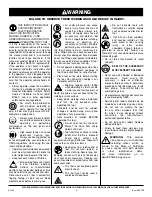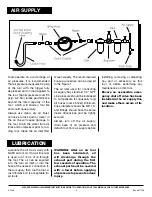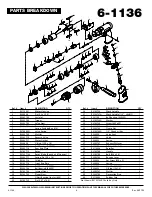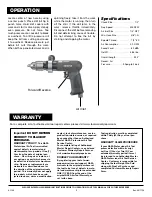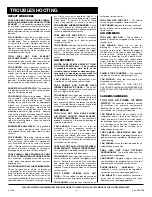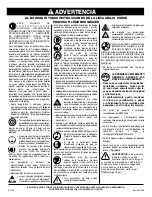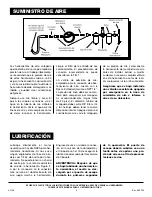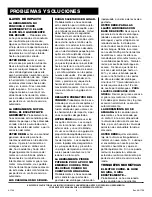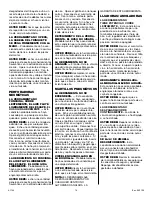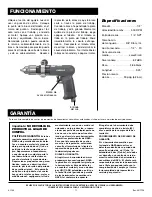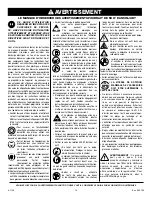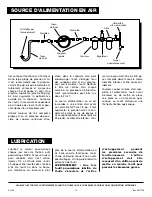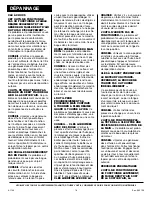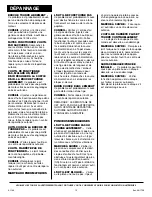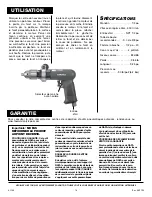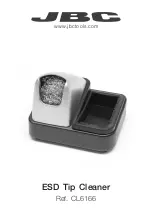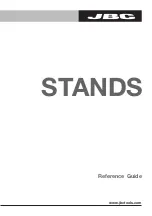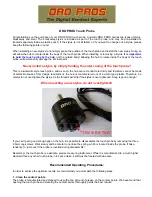
6-1136
6
Rev. 09/17/18
TROUBLESHOOTING
IMPACT WRENCHES
TOOL DOES NOT RUN OR RUNS SLOWLY,
AND/OR AIR FLOWS ONLY SLIGHTLY FROM
EXHAUST —
This condition is probably caused
by insufficient air pressure, contaminants block-
ing the airflow or operation of motor parts, or a
power regulator which has vibrated to a closed
position.
YOU SHOULD:
Check the air supply for suf-
ficient pressure. Check the air inlet strainer
for blockage. Pour a generous amount of
air tool oil into air inlet. Operate tool in short
bursts, in both forward and reverse directions.
Repeat if necessary. If tool performance does
not improve, the tool should be serviced by an
authorized service center.
TOOL WILL NOT RUN, EXHAUST
AIR FLOWS FREELY.
This condition is proba-
bly caused by one or more rotor vanes stuck on
ac cu mu la ted sludge or varnish; motor rusted.
YOU SHOULD:
Pour a generous amount of
air tool oil into air inlet. Operate tool in short
bursts in both forward and reverse directions.
Lightly tap the motor housing with a plastic
mallet. Detach the air supply. Try to free the
motor by turning the drive shaft manually, if
possible. If the tool remains jammed, it should
be serviced by an authorized service center.
SOCKETS WILL NOT STAY ON.
This condition
is probably caused by a worn socket retainer
ring or a soft backup o-ring
YOU SHOULD:
Wear safety goggles. Detach
the air supply. Using external retaining ring
pliers, remove the old retaining ring. While
holding the square drive with an appropriate
wrench, use a small screwdriver to pry old
retainer ring out of its groove. Always pry the
ring away from your body, because it can be
propelled outward at high velocity. Replace
the backup o-ring and retainer ring with correct
new parts (see breakdown). Place the retaining
ring on a table and press the tool anvil into the
ring with a rocking motion. Snap the ring into
the groove by hand.
PREMATURE ANVIL WEAR.
This is probably
cased by using chromed sockets, which are
not designed for use with impact tools, or worn
sockets
YOU SHOULD:
Stop using chrome sockets.
Chrome sockets have a hard exterior surface
and a soft core, which leads to a warped but
very hard drive hole when used with impact
tools. Chrome sockets will wear wrench anvils
quickly and present a danger of splitting or
breakage which can lead to injury or death.
TOOL SLOWLY LOSES POWER BUT RUNS
AT FULL SPEED WHEN NOT UNDER LOAD.
This condition is probably caused by worn
clutch parts, inadequate lubrication, or worn
engaging cam.
YOU SHOULD: FOR OIL LUBED WRENCHES:
Check for presence of clutch oil (where oil
is specified for the clutch) and remove oil fill
plug. Tilt to drain all of the oil from the clutch
case. Refill the case with NAPA air tool oil or
that recommended by the manufacturer in the
specified amount. Also check for excess clutch
oil. Clutch cases only need to be filled 50%,
and overfilling can cause drag on high speed
clutch parts. A typical 1/2" Drive oil lubed
wrench only requires 1/2 ounce of clutch oil.
FOR GREASE LUBED WRENCHES:
Check
for excess grease by rotating drive shaft by
hand. It should rotate freely, and excess grease
is usually expelled automatically.
TOOL WILL NOT SHUT OFF.
This condition
is probably cause by a broken or maligned
throttle valve O-ring, or a bent or jammed
throttle valve stem.
YOU SHOULD:
Remove the throttle assembly
and install a new o-ring. Lubricate the assem-
bly with air tool oil and operate the trigger
briskly. If operation cannot be restored, the
tool should be serviced at an authorized service
center.
AIR RATCHETS
MOTOR RUNS. SPINDLE DOESN'T TURN,
OR TURNS ERRATICALLY —This condition
is probably caused by worn teeth on the
ratchet or pawl, a broken or weak pawl pres-
sure spring, or weak drag springs which fail
to hold the spindle while the pawl advances.
YOU SHOULD:
Have replacement parts
installed by an authorized service center.
TOOL DOESN’T RUN, RATCHET HEAD
INDEXES CRISPLY BY HAND—
This condi-
tion is probably caused by the accumulation of
dirt or sludge in motor parts.
YOU SHOULD:
Pour a generous amount of air
tool oil into the air inlet. Operate the throttle
in short bursts. With the tool engaged on a
bolt, alternately tighten and loosen the bolt by
hand. If the tool remains jammed, it should be
serviced at an authorized service center
AIR DRILLS
TOOL WILL NOT RUN, RUNS SLOWLY,
AIR FLOWS SLIGHTLY FROM EXHAUST,
SPINDLE TURNS FREELY —
This condition is
probably caused by a blocked air passage or
jammed motor parts.
YOU SHOULD:
Check the air inlet for
blockages. Pour a generous amount of
air tool oil into air inlet. Operate the trigger
in short bursts. Detach the air supply. Turn
the empty and closed drill chuck by hand.
Reconnect air supply. If the tool’s performance
does not improve, it should be serviced by an
authorized service center.
TOOL WILL NOT RUN. AIR FLOWS FREELY
FROM EXHAUST. SPINDLE TURNS FREELY.
This condition is prob a bly caused by a broken
rotor vane or jammed or broken gears.
YOU SHOULD:
Pour a generous amount of air
tool oil into air inlet. Operate the trigger in short
bursts. Detach the air supply. Turn the empty
and closed drill chuck by hand. Reconnect
air supply. If the tool’s performance does not
improve, it should be serviced by an authorized
service center.
TOOL SEIZED. SPINDLE WILL NOT
TURN —
This condition is probably caused by
a broken rotor vane or jammed or broken gears.
YOU SHOULD:
Have the tool serviced by an
authorized service center.
TOOL WILL NOT SHUT OFF —
The throttle
valve o-ring has probably come unseated.
YOU SHOULD:
Replace the o-ring (see break-
down) or have tool serviced by an authorized
service center.
AIR HAMMERS
TOOL WILL NOT RUN —
This condition is
probably caused by a clogged cycling valve or
throttle valve.
YOU SHOULD:
Check the air inlet for
blockages. Pour a generous amount of
air tool oil into air inlet. Operate the trigger in
short bursts with the chisel in place and against
a solid surface. Detach the air supply. Tap
the nose or barrel lightly with a plastic mallet,
reconnect the air supply, and repeat above
steps. If the tool is still seized, insert a 6" piece
of 1/8" diameter rod in the nozzle and lightly
tap to loosen the piston in the rear direction.
Reconnect air supply and repeat above steps.
CHISEL STUCK IN NOZZLE—
This condition
is probably caused by a deformed shank.
YOU SHOULD:
Have tool serviced by an
authorized service center.
NOTE: DISASSEMBLY OF THIS TOOL BY
ANY OTHER THAN AN AUTHORIZED SERVICE
CENTER WILL VOID THE WARRANTY ON THIS
TOOL.
SANDERS/GRINDERS
TOOL HAS NO POWER OR RUNS
SLOWLY.
This condition is probably caused
by insufficient air pressure, contaminants
blocking the air flow, or speed regulator that
has vibrated to a closed or off position.
YOU SHOULD:
Check the air supply at the
compressor and air lines to the tool for suf-
ficient air pressure. Check the air inlet strainer
for blockage and make sure speed regulator
is in the open or on position. If power is not
restored the tool should be serviced by an
authorized service center.
TOOL SEIZED. PAD/SPINDLE WILL NOT
TURN.
This condition is probably caused by a
broken rotor vane, jammed or broken gears, or
seized bearing.
YOU SHOULD:
Have the tool repaired by an
authorized service center
.
TOOL WILL NOT SHUT OFF/RUNS
CONTINUOUSLY.
The throttle valve seat has
become loose or damaged.
YOU SHOULD:
Replace o-ring or valve seat
(see breakdown for proper parts) or have tool
serviced by an authorized service center.
SANDS/GRINDS UNEVENLY.
This
condition is usually caused by loose pad/disc
connection or worn or damaged pad/disc.
YOU SHOULD:
Check pad/disc connection,
ensure that connection is secure and tight.
Replace worn or damaged pad/disc.
PLEASE REVIEW ALL WARNING INSTRUCTIONS PRIOR TO OPERATION. SAVE THIS MAN U AL FOR FUTURE REF ER ENCE.


